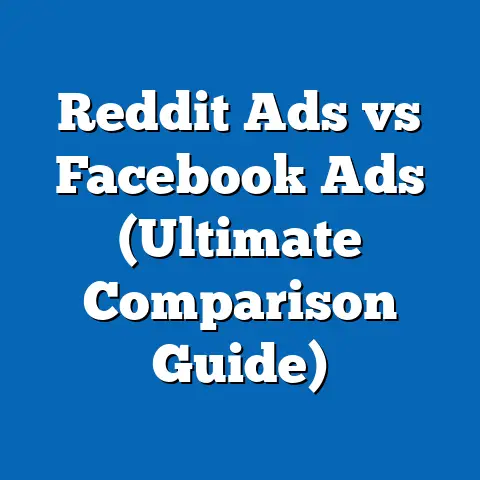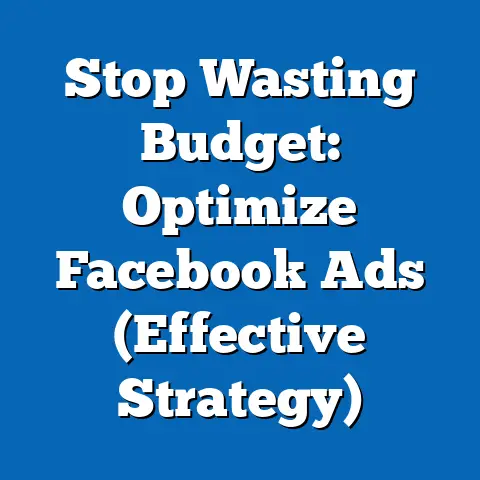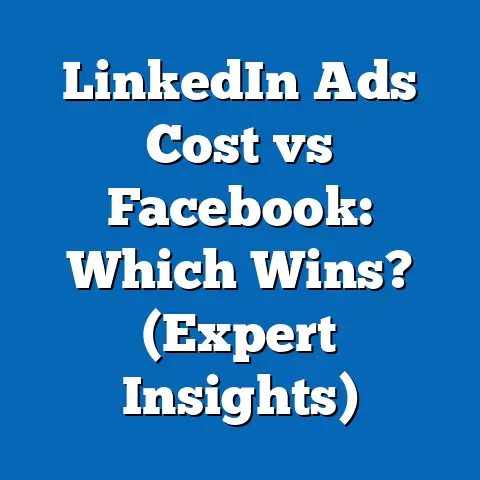Master Facebook Ads Overlap (Maximize Reach!)
As a digital marketing specialist, I’ve seen firsthand how a well-oiled Facebook Ads strategy can be a game-changer for businesses. It’s not just about throwing money at ads; it’s about strategic targeting, compelling creatives, and understanding the nuances of the platform. Think of it like this: a successful Facebook Ads campaign can significantly boost a business’s “resale value” by driving customer engagement, increasing brand awareness, and ultimately, boosting conversion rates. When potential buyers see a thriving online presence fueled by effective advertising, they see a valuable asset.
But here’s the kicker: simply running ads isn’t enough. You need to ensure your advertising budget is working as efficiently as possible. That’s where mastering Facebook Ads overlap comes in. It’s a critical skill for maximizing reach, avoiding ad fatigue, and ensuring that every dollar you spend delivers the highest possible return on investment (ROI). In this guide, I’ll walk you through everything you need to know to conquer ad overlap and unlock the full potential of your Facebook advertising.
Understanding Facebook Ads Overlap
So, what exactly do I mean by “ads overlap”? In the Facebook advertising world, overlap happens when the same users are targeted by multiple ad sets within your campaigns. This isn’t inherently bad, but if left unchecked, it can lead to a host of problems.
Why Does Overlap Occur?
The sheer number of targeting options available on Facebook is the primary culprit. You can target people based on:
- Demographics: Age, gender, location, education, job title, etc.
- Interests: Hobbies, pages they’ve liked, groups they’ve joined.
- Behaviors: Purchase history, device usage, travel habits.
- Custom Audiences: Lists of existing customers, website visitors, app users.
- Lookalike Audiences: People who share similar characteristics with your existing customers.
With so many ways to slice and dice your audience, it’s easy to accidentally create ad sets that target the same individuals. Let’s say you’re selling running shoes. You might create one ad set targeting people interested in “running” and another targeting people interested in “marathons.” It’s highly likely that many people fall into both categories.
The Implications of Overlap
While a little overlap might seem harmless, excessive overlap can have several negative consequences:
- Audience Saturation: Showing the same ads to the same people repeatedly leads to ad fatigue. They’ll start ignoring your ads, and your click-through rates will plummet. I’ve personally experienced this when I got too aggressive with retargeting, bombarding users with the same message until they tuned me out completely.
- Increased Costs: You’re essentially bidding against yourself. When multiple ad sets target the same people, they compete for the same impressions, driving up your costs. I once witnessed a client unknowingly doubling their CPA (Cost Per Acquisition) simply because they had significant audience overlap.
- Wasted Budget: If people are already seeing your ads through one ad set, you’re wasting money showing them the same ad through another. That budget could be better spent reaching new potential customers.
- Skewed Data: Overlap can make it difficult to accurately assess the performance of individual ad sets. If the same users are being influenced by multiple ads, it’s hard to determine which ad is truly driving conversions.
Takeaway: Understanding the causes and implications of ad overlap is the first step towards optimizing your Facebook Ads strategy. It’s crucial to be aware of the potential pitfalls and proactively take steps to minimize unnecessary overlap.
The Importance of Audience Segmentation
Effective audience segmentation is your secret weapon in the fight against ad overlap. By carefully defining and separating your target audiences, you can ensure that your ads are reaching unique users and maximizing your budget.
Segmentation Strategies
Here are some common segmentation strategies you can use:
- Demographic Targeting: This is the most basic form of segmentation, but it can still be effective when used strategically. For example, if you’re selling skincare products, you might segment your audience by age and gender.
- Interest-Based Targeting: This allows you to target people based on their hobbies, passions, and interests. It’s a great way to reach people who are actively engaged in a particular niche. Going back to the running shoe example, you could target people interested in specific running brands, running events, or running magazines.
- Custom Audiences: These are audiences you create based on your own data. You can upload lists of existing customers, website visitors, or app users. Custom audiences are incredibly powerful because they allow you to target people who are already familiar with your brand. I’ve had great success using custom audiences to retarget website visitors who abandoned their shopping carts.
- Lookalike Audiences: These are audiences that Facebook creates based on your custom audiences. Facebook analyzes the characteristics of your existing customers and finds other people who share similar traits. Lookalike audiences are a fantastic way to expand your reach while maintaining relevance. I’ve seen lookalike audiences consistently outperform broad targeting options.
Examples of Effective Segmentation
Let’s look at a few examples of how businesses can segment their audiences to avoid overlap:
- E-commerce Store Selling Clothing: Instead of targeting all women aged 25-45, segment your audience based on their style preferences. Create separate ad sets for women interested in “bohemian fashion,” “classic style,” or “athleisure.”
- Local Restaurant: Segment your audience based on their location and dining preferences. Target people who live within a 5-mile radius and are interested in “Italian food,” “Mexican food,” or “vegetarian cuisine.”
- Software Company: Segment your audience based on their job title and industry. Target marketing managers in the tech industry with one ad set and sales directors in the finance industry with another.
Takeaway: Audience segmentation is the foundation of a successful Facebook Ads strategy. By carefully defining and separating your target audiences, you can minimize overlap, maximize reach, and improve your ROI.
Tools and Techniques for Identifying Ads Overlap
Facebook Ads Manager offers several tools and features that can help you identify overlap between your campaigns.
Facebook Audience Overlap Tool
The most direct way to check for audience overlap is by using Facebook’s built-in Audience Overlap tool. Here’s how to access it:
- Go to Ads Manager.
- Select the audiences you want to compare. You can select custom audiences, saved audiences, or lookalike audiences.
- Click on the three dots “…” and choose “Show Audience Overlap.”
This tool will show you the percentage of people who are in both audiences, as well as the percentage of each audience that is unique. It’s a quick and easy way to identify potential overlap issues. I frequently use this tool to compare my custom audiences with my lookalike audiences to ensure I’m not targeting the same people twice.
Audience Insights
Audience Insights is another valuable tool for understanding your target audience. It allows you to analyze the demographics, interests, and behaviors of people who are connected to your Facebook page or who are in your custom audiences.
By analyzing Audience Insights, you can identify potential overlap between your different target audiences. For example, if you see that a large percentage of people in your “running” audience are also interested in “marathons,” you might consider combining those two audiences into a single ad set.
A/B Testing
A/B testing is a powerful technique for determining the most effective targeting strategy. By creating multiple ad sets with different targeting options and comparing their performance, you can identify which audiences are most responsive to your ads.
A/B testing can also help you identify overlap issues. If you see that two ad sets with similar targeting options are performing poorly, it’s likely that they are targeting the same people.
Takeaway: Facebook provides several tools to help you identify ad overlap. Regularly use the Audience Overlap tool, analyze Audience Insights, and conduct A/B tests to optimize your targeting strategy and minimize unnecessary overlap.
Strategies to Optimize Ad Overlap
Now that you understand the importance of audience segmentation and how to identify overlap, let’s dive into some actionable strategies to reduce overlap and maximize reach.
Utilizing Lookalike Audiences Strategically
Lookalike audiences are a powerful tool for expanding your reach, but they can also contribute to overlap if not used carefully. Here’s how to use them strategically:
- Layer Targeting: Instead of targeting a broad lookalike audience, layer additional targeting options on top. For example, you could target a lookalike audience of your existing customers who are also interested in “sustainable living.” This helps narrow down your audience and reduce overlap with other ad sets.
- Exclude Existing Customers: When targeting a lookalike audience, exclude your existing customers. This ensures that you’re only reaching new potential customers. I always exclude my customer list when running lookalike campaigns, as it avoids showing ads to people who have already purchased.
- Test Different Seed Audiences: Experiment with different seed audiences for your lookalike audiences. For example, you could create a lookalike audience based on your top 10% of customers or a lookalike audience based on your website visitors. Testing different seed audiences can help you find the most responsive audience.
Implementing Frequency Caps
Frequency caps limit the number of times a person sees your ad within a specific timeframe. This is a crucial strategy for preventing ad fatigue and reducing overlap.
Here’s how to implement frequency caps:
- Go to your ad set settings.
- Under “Optimization & Delivery,” click “Show Advanced Options.”
- Set a frequency cap. I typically recommend setting a frequency cap of 2-3 impressions per week.
Experiment with different frequency caps to find the optimal balance between reach and frequency. I’ve found that a slightly lower frequency cap often leads to better results, as it prevents ad fatigue without significantly reducing reach.
Scheduling Ads Strategically
Scheduling your ads can also help reduce overlap and maximize reach. By varying the times of day and days of the week that your ads are shown, you can reach different segments of your audience.
For example, if you’re targeting working professionals, you might schedule your ads to run during their lunch breaks or after work hours. If you’re targeting students, you might schedule your ads to run during the evenings or weekends.
Case Study: Successful Overlap Management
I worked with an e-commerce client who was struggling with ad fatigue and high costs. After analyzing their campaigns, I discovered significant overlap between their retargeting ad sets and their prospecting ad sets.
To address this issue, I implemented the following strategies:
- Excluded Website Visitors: I excluded website visitors from their prospecting ad sets to avoid showing the same ads to people who had already visited their website.
- Implemented Frequency Caps: I set a frequency cap of 2 impressions per week on all of their retargeting ad sets.
- Layer Targeting on Lookalike Audiences: I layered interest-based targeting on top of their lookalike audiences to narrow down their reach and reduce overlap with other ad sets.
As a result of these changes, their ad costs decreased by 30%, and their conversion rates increased by 15%. This demonstrates the power of effectively managing ad overlap.
Takeaway: Utilize lookalike audiences strategically, implement frequency caps, and schedule your ads to reduce overlap and maximize reach. These strategies can significantly improve your campaign performance and reduce your ad costs.
Measuring Success and Adjusting Strategies
It’s not enough to simply implement these strategies and hope for the best. You need to continuously monitor your campaign performance and adjust your strategies based on the data.
Key Performance Indicators (KPIs)
Here are some key performance indicators (KPIs) that you should monitor to assess the effects of ad overlap on your campaign performance:
- Reach: The number of unique people who saw your ads.
- Frequency: The average number of times each person saw your ad.
- Click-Through Rate (CTR): The percentage of people who clicked on your ad.
- Cost Per Click (CPC): The average cost of each click on your ad.
- Conversion Rate: The percentage of people who took a desired action after clicking on your ad (e.g., making a purchase, filling out a form).
- Cost Per Acquisition (CPA): The average cost of acquiring a new customer.
If you see that your frequency is high and your CTR is low, it’s a sign that you have too much ad overlap. Similarly, if your CPA is high, it could be due to inefficient targeting and wasted budget.
Analyzing Metrics and Making Informed Decisions
Regularly analyze your metrics and look for trends. Are your costs increasing over time? Is your reach declining? Are your conversion rates dropping?
Based on your analysis, make informed decisions about how to adjust your strategies. You might need to refine your targeting options, adjust your frequency caps, or experiment with different ad creatives.
Continuous Improvement
Facebook advertising is an ongoing process. You need to continuously test, analyze, and optimize your campaigns to stay ahead of the curve. Don’t be afraid to experiment with new strategies and learn from your mistakes.
Takeaway: Monitor your KPIs, analyze your metrics, and continuously adjust your strategies to improve your ad performance and minimize the negative effects of ad overlap.
Future Trends in Facebook Advertising
The world of Facebook advertising is constantly evolving. It’s important to stay up-to-date on the latest trends and technologies to remain competitive.
The Role of AI and Machine Learning
Artificial intelligence (AI) and machine learning (ML) are playing an increasingly important role in Facebook advertising. Facebook is using AI and ML to optimize ad targeting, personalize ad creatives, and automate campaign management.
In the future, AI and ML will likely play an even bigger role in minimizing ad overlap. Facebook’s algorithms will be able to identify and prevent overlap in real-time, ensuring that your ads are always reaching the right people at the right time.
The Future of Personalized Advertising
Personalized advertising is the future. Consumers are increasingly demanding personalized experiences, and businesses that can deliver personalized ads will have a significant advantage.
In the future, Facebook will likely offer even more sophisticated personalization options. You’ll be able to target people based on their individual interests, preferences, and behaviors. This will allow you to create highly relevant and engaging ads that resonate with your target audience.
Takeaway: Stay informed about emerging trends in Facebook advertising, particularly the role of AI and personalized advertising. These trends will likely have a significant impact on how you manage ad overlap and optimize your campaigns in the future.
Conclusion
Mastering Facebook Ads overlap is essential for maximizing reach, reducing ad fatigue, and improving your ROI. By understanding the causes and implications of overlap, implementing effective segmentation strategies, utilizing the tools and techniques available in Ads Manager, and continuously monitoring your campaign performance, you can unlock the full potential of your Facebook advertising.
Remember, a well-executed Facebook Ads campaign can significantly increase the “resale value” of your business. By driving customer engagement, increasing brand awareness, and boosting conversion rates, you’re creating a valuable asset that will attract potential buyers.
Now it’s your turn. Take the strategies discussed in this article and implement them in your own advertising efforts. Start by analyzing your existing campaigns for potential overlap issues. Then, refine your targeting options, implement frequency caps, and schedule your ads strategically. Monitor your KPIs and adjust your strategies based on the data.
By taking these steps, you’ll be well on your way to mastering Facebook Ads overlap and maximizing the reach and impact of your advertising campaigns. Good luck!





